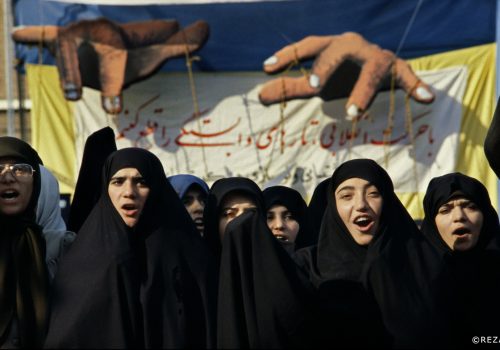On the first day, the brutal light breaks the reassuring cocoon of the interior night. The eyes, long familiar with the reassuring darkness of the mother’s lair, hesitate to open up to this new world. For some time yet, nature protects him with a veil. It attenuates the vividness of colors, the threat of moving forms, the violence of the meeting of shadow with light. Immersed in this partial blindness, the born child feeds on the other awakened senses; he builds a subjective and poetic visual universe.
Reality is slowly emerging over the weeks. The blurred contours become clearer. So the world reveals itself as it is in the ambivalence of its cruelty and its humanity.
The Iranian Islamic Revolution changed the eyes of two brothers, Manoocher Deghati and Reza. Immersed in the heart of the shattered dream of a betrayed Revolution and the chaos it generated, she gave birth to them as photojournalists. Since then, here and there, they have been bearing witness to raw barbarism in constant search for traces of a manhandled mankind.
In the Iran of the carefree past, trained in the colorful arabesques of the Persian carpets and the epics of the Book of Kings by the poet Ferdowsi, Manoocher and Reza choose very young, to tell their world in pictures. Using a camera donated by their uncle, they found their pen. The film then became a blank writing page on which they learne by themselves to write with light. They discovered themselves visual explorers. From this period of initiation, there are still a few black and white prints.
As adults, a restrained breeze made the air in the first months of 1978 in Iran quiver. The rare attentive and enlightened observer understands that a storm will cross the country and overturn the order of the world. Behind the scenes, the actors are agitated. Opponents are joining forces. A new era is well worth some temporary ideological compromises. In this chess game, the foreign powers, makers of kings and pariahs advance their pawns, praising Khomeini to the skies, and heaping opprobrium on the Shah of Iran. Over the months of this pivotal year, we hear the roar of the crowd. It massively invades the streets and places of its hopes. It braves repressions, bans and lethal army shootings. One day, Reza hears the cries of angry demonstrators: “Marg bar Chah!”, “Down with the Chah!”. He is at the window of the architectural firm in which he works. He sees a student running while taking pictures of the scene. Reza is in shock. He has a revelation: the camera is not only a means of expression but also a tool of testimony. He takes three days off and will never return. In Rome, Manoocher follows with passion the events which agitate his country. He sees the joy of an era of change. He is divided between his desire to become a film director that keeps him in Rome and that, even more imperative, of being present at this turning point in history. Khomeini’s return in February 1979 decided him. Upon arriving in Tehran, he seized a camera.
The Islamic Revolution which agitated their country, diverted them from their primary vocation of filmmaker and architect and revealed them photoreporters animated by an insatiable duty to witness. Reza and Manoocher covered the different faces of the Revolution. It all starts with a collective jubilation. They observed the gradual shift of society towards instability, chaos, violence, collective hysteria, repression against women and opponents, public executions, the abuses of the mullahs ’regime. They shared the events to be covered, from the hostage-taking of the American embassy to the armed conflicts against the Turkmen, Baluchi, Khuzestan and Kurdish minorities until the war between Iran and Iraq. The media of the world discovered through the images of the two brothers, the impact of their visual narration. So, years of testimonials opened for the biggest media. They collaborated with Times, Newsweek, Agence France Presse, Life and Paris Match magazines, Stern and many other publications. Their photographs revealed a face of the complex realities of a people bruised by an Islamic Republic which does not keep its promises of social justice or peace. Reza in 1981 and Manoocher in 1985 were victims of the parution of their images in the international media, and forced into exile to save their lives.
Several decades after Iran’s departure, on the sometimes difficult path of exodus, exile to these welcoming lands of refuge, remains the refuge in which Manoocher and Reza strive to continue to build and live. In each of them remains the memory of the lost country. And if the taste for freedom inhabits them, their soul retains the discreet trace of a physical and intellectual crack in the mourning of their land. Each stopover on this homelessness gave the two brothers another richer dimension. Having become eminent personalities in the world of photojournalism, each continued their journey as a witness through images. From nowhere and everywhere, from here and elsewhere, they have taken on the concept of universality and the world has become their home.
Rachel DEGHATI
Reza et Manoocher Deghati : Iran, Rêves et Dérives
Éditions Hoëbeke
288 pages / 22 x 25 cm / 39 €
ISBN : 9782842307301
http://www.gallimard.fr/Catalogue/HOEBEKE/Photographie/Iran-reves-et-derives
















